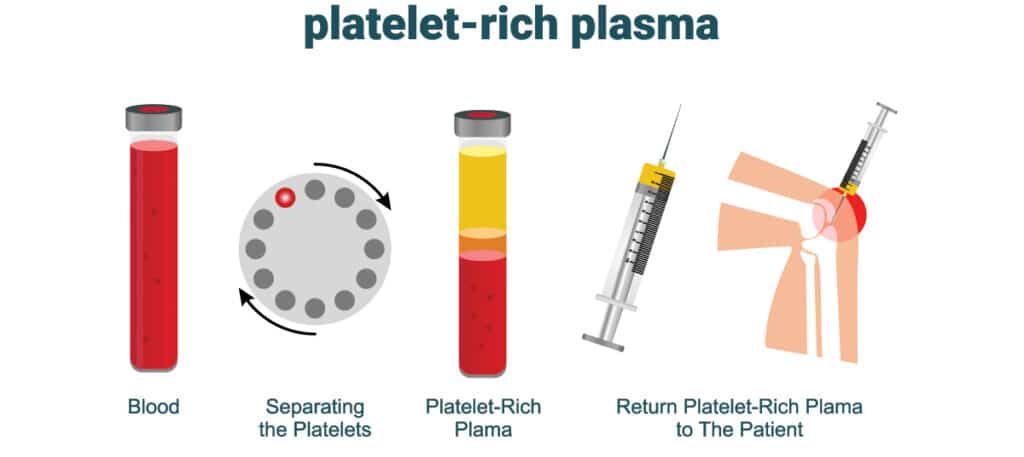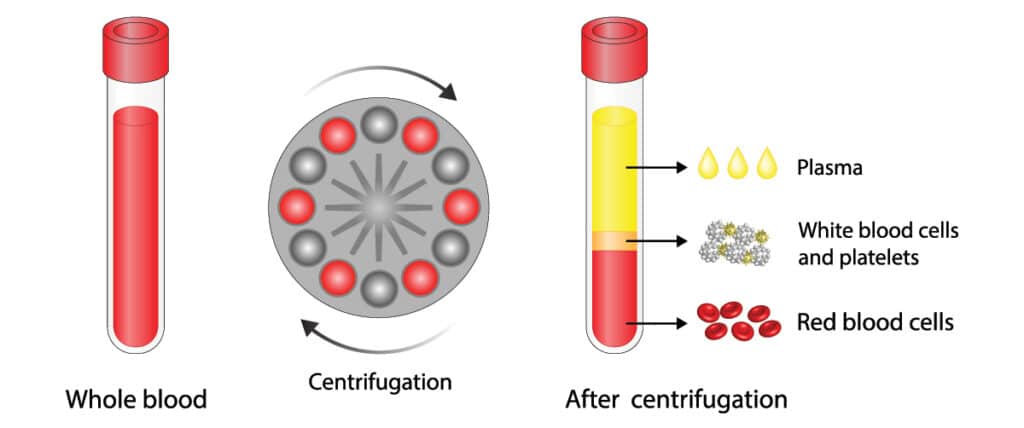What is Platelet Rich Plasma (PRP)?
Platelet-rich plasma (PRP) as a biological agent has gained popularity over the last decade or more in treating a wide variety of conditions in different fields of medicine. Basically, a patient’s blood is collected and centrifuged at varying speeds until it separates into 3 layers: platelet poor plasma (PPP), PRP, and red blood cells. Usually, 2 spins are used.
Platelets play a fundamental role in hemostasis and are a natural source of growth factors. Growth factors, stored within platelet α-granules, include platelet derived growth factor (PDGF), insulin like growth factor (IGF), vascular endothelial growth factor (VEGF), platelet derived angiogenic factor (PDAF), and transforming growth factor beta (TGF-β). The release of these growth factors is triggered by the activation of platelets that can be initiated by a variety of substances or stimuli such as thrombin, calcium chloride, or collagen.
Although PRP has been in use since the 1980s and has gained increasing popularity over time, there continue to be controversies and conflicting results regarding its effectiveness and the scope of its applicability in treating clinical conditions. Today, the scope within which PRP is being used is vast, including orthopedics, regenerative medicine (melasma, skin rejuvenation, periorbital hyperpigmentation, hair growth, scars/stretch marks, psoriasis and vitiligo), Rheumatoid arthritis, maxillofacial (temporomandibular osteoarthritis [OA]), non-diabetic foot ulcers, laryngeal application (vocal cord scarring), erectile dysfunction (Peyronie’s disease), retinitis pigmentosa, vaginal atrophy and even infertility (intra-ovarian injections).


The Science Behind PRP
PRP is full of different growth factors, each of which has their own primary function as listed below:
| Growth Factor | Primary Function |
|---|---|
| Epidermal Growth Factor | Regulation of cell proliferation, differentiation and survival |
| Insulin like Growth Factor | Key regulator of cell metabolism and growth Stimulates proliferation and differentiation function in osteoblasts. |
| Platelet derived Growth Factor | Major mitogen for connective tissue cells and certain other cell types Promotes the synthesis of collagen and structural proteins |
| Transforming Growth Factors | Regulation of cell proliferation, differentiation and apoptosis Induction of intimal thickening |
| Vascular Endothelial Growth Factor | Regulation of Angiogenesis |
PRP achieves its results through multiple mechanisms of actions as follows:
Cell proliferation & Tissue differentiation
- Promotes Tenocyte & Tenocyte stem cell proliferation in vitro
- Accelerate the proliferation rates of circulating stem cells such as bone marrow stem cells and adipose derived stem cells thereby accelerating tendon healing
- Positively influence cell attachment and spreading on the fibrin scaffold, as well as promoting cell proliferation
Anabolic effects
- Influence the metabolism of tendon cells
- Increase total collagen synthesis in tenocytes
- Specifically enhance the gene expression of collagen types I and III
- Enhances expression of COMP, decorin and tenascin-C (tendon healing glycoproteins)
Anti-inflammatory effects
- Induce release of HGF (major anti-inflammatory growth factor)
- Increased VEGF and HGF expression in tendonopathy tendons
- Reduction in the levels of COX-1, COX-2 and PGE2, pro-inflammatory cytokines, IL-6, CXCL-6 and IL-8
- Increase anti-inflammatory cytokine IL-10 & TGF-β levels
Antibiotic effects
- Active role in sepsis and fighting infection
- Significantly decreased bacterial growth of MRSA, P. acnes, S. epidermidis and S. aureus
What Technology Do We Use?

We utilize Refine USA’s Sapphire Centrifuge with their PureSpin PRP closed system cartridges. Using a double spin technique, your PRP is prepared for direct injection into the affected joint. Immediately after injection, we encourage the use and mobility of the joint to help spread the PRP into the surrounding tissues. We also can utilize synergistic therapies such as local cryotherapy and local light therapy as part of your treatment plan.
Key Features
Pre-Programmed Settings
The user-friendly preset touch screen interface allows clinicians to quickly initiate the processing cycle for each biologic. Sapphire reduces the chance of human error, making it safer and more effective.
Customization When You Need It
Sapphire has an “open settings” feature, allowing clinicians to customize the machine’s parameters beyond the present settings. This accommodates new protocol requirements.
One Machine, 3 Biologics
Sapphire prepares platelet-rich plasma, bone marrow concentrate, and adipose concentrate on a single platform. This narrows the investment portfolio and consolidates the procedure setup, leading to an increase in the efficiency of the overall preparation experience.
Why We Chose PureSpin PRP
- True PRP concentrated double spin closed system
- FDA registered and ISO certified
- Highest platelet recovery yield of 81%
- Greatest concentration of deliverable platelet 4-6 (x) times/whole blood baseline
- 2% granulocyte recovery with the perfect blend of WBCs
- 1% hematocrit
- Process time is 6 minutes and shortest of all the viable tabletop systems

